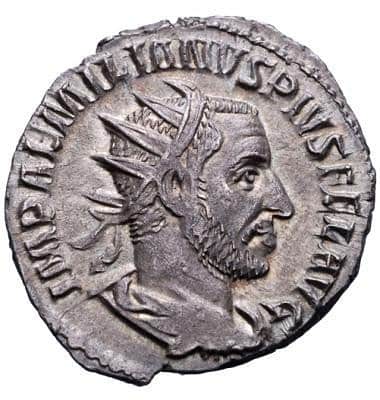Life: AD c. 206 – 253

- Name: Marcus Aemilius Aemilianus
- Born AD ca. 207.
- Became emperor in July/August AD 253.
- Wife: Gaia Cornelia Supera.
- Died at Spoletium, October AD 253.
Marcus Aemilius Aemilianus was born about AD 207 either on the island of Jerba in Africa, or somewhere in Mauretania.
His career saw him becoming senator and reaching the office of consul. In AD 252 he then became governor of Lower Moesia.
In the spring of AD 253 the Goths broke the treaty made with the emperor Trebonianus Gallus. Aemilian quickly drove them out of Moesia and then, crossed the Danube crushing the Gothic forces.
In a time when Rome suffered continuous setbacks his unexpected triumph made him an outstanding leader in the eyes of his men. So, in July or August AD 253 Aemilian was proclaimed emperor by his troops. The new emperor didn’t waste time. Immediately he marched his troops into Italy, rapidly moving on Rome. Only fifty miles north of the capital, at Interamna, they were were approached by the much inferior army of unprepared emperor Gallus and with his son and co-emperor Volusianus. Their troops however, realizing themselves dead if they were sent to fight Aemilian’s much larger and more experienced Danubian forces, turned on them and killed them, leaving Aemilian sole emperor.
The senate, having only recently declared Aemilian a public enemy under Gallus, immediately confirmed him as emperor and Aemilian’s wife Gaia Cornelia Supera was made Augusta.
All the empire now lay at Aemilian’s feet, but for one big problem. Publius Licinius Valerianus, called to aid by the late Trebonianus Gallus, was marching toward Rome. His emperor might have been dead, but his usurper was still alive, giving Valerian all the reasons needed to carry on towards the capital. In fact the soldiers of his Rhine armies now declared him emperor in place of Aemilian.
As Aemilian now moved north to face his challenger history repeated itself. His own soldiers not wanting to fight a army they thought superior to their own, turned on him near Spoletium and stabbed him to death (October AD 253). The bridge where he died was afterwards known as the pons sanguinarius, the ‘bridge of blood’.
Aemilian had ruled for only 88 days.

Historian Franco Cavazzi dedicated hundreds of hours of his life to creating this website, roman-empire.net as a trove of educational material on this fascinating period of history. His work has been cited in a number of textbooks on the Roman Empire and mentioned on numerous publications such as the New York Times, PBS, The Guardian, and many more.
